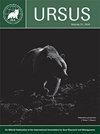Survey on gastro-intestinal parasites of captive sun bears in Malaysia
IF 0.8
4区 生物学
Q4 ZOOLOGY
引用次数: 0
Abstract
Abstract: This study aimed to investigate parasitic infection in captive sun bears (Helarctos malayanus) in Malaysia from December 2018 to May 2019. We collected 58 fecal samples from sun bears housed in the National Zoo, Taiping Zoo & Night Safari, Lok Kawi Wildlife Park, and Bornean Sun Bear Conservation Centre. We analyzed the samples using modified fecal flotation techniques. We found 4 species of helminths (Ancylostoma spp., Baylisascaris spp., Trichuris spp., and Strongyloides spp.) and 1 species of protozoa (Eimeria spp.) in captive sun bears. The general prevalence of infection was 55.2%, with 48.3% prevalence of helminth infections and 34.5% protozoic infections. Juvenile males (69.2%) and juvenile females (61.5%) had the highest prevalence of parasitic infection. For nematodes, Baylisascaris spp. and Ancylostoma spp. had ≥50% prevalence rate in captive bears. For protozoa, the prevalence rate was <50%. We also found a high intensity of infection for Ancylostoma spp. in captive sun bears with a mean of 258.24 ± 0.62 eggs per gram (EPG), and the lowest intensity was recorded for Strongyloides spp. with 34.37 ± 1.17 EPG. Generally, the parasites we found were common in other species of bears and other mammals. This study revealed presence of parasites that could affect the well-being of sun bears in captivity. Therefore, we suggest that fecal screening be done regularly at 3-month intervals, and that it is essential to reduce the degree of parasitic infection in captive animals.马来西亚圈养太阳熊胃肠道寄生虫调查
摘要:本研究旨在调查2018年12月至2019年5月马来西亚圈养马来熊(Helarctos malayanus)的寄生虫感染情况。我们从国家动物园、太平动物园和夜间野生动物园、乐卡威野生动物园和婆罗洲马来熊保护中心收集了58个马来熊的粪便样本。我们使用改良的粪便浮选技术对样品进行分析。在圈养马来熊体内发现4种蠕虫(钩虫、Baylisascaris、Trichuris、Strongyloides)和1种原生动物(艾美耳球虫)。总感染率为55.2%,其中蠕虫感染率为48.3%,原生动物感染率为34.5%。青少年男性(69.2%)和青少年女性(61.5%)的寄生虫感染率最高。线虫方面,贝氏蛔虫和钩虫在圈养熊中患病率≥50%。原生动物患病率<50%。圈养太阳熊的感染强度最高,平均为258.24±0.62个/ g (EPG),而圆线虫的感染强度最低,为34.37±1.17个/ g。一般来说,我们发现的寄生虫在其他种类的熊和其他哺乳动物中很常见。这项研究揭示了可能影响圈养马来熊健康的寄生虫的存在。因此,我们建议每隔3个月定期进行粪便筛查,这对降低圈养动物的寄生虫感染程度至关重要。
本文章由计算机程序翻译,如有差异,请以英文原文为准。
求助全文
约1分钟内获得全文
求助全文
来源期刊

Ursus
生物-动物学
CiteScore
2.00
自引率
15.40%
发文量
12
审稿时长
>12 weeks
期刊介绍:
Ursus includes a variety of articles on all aspects of bear management and research worldwide. Original manuscripts are welcome. In addition to manuscripts reporting original research, submissions may be based on thoughtful review and synthesis of previously-reported information, innovative philosophies and opinions, and public policy or legal aspects of wildlife conservation. Notes of general interest are also welcome. Invited manuscripts will be clearly identified, but will still be subject to peer review. All manuscripts must be in English. All manuscripts are peer-reviewed, and subject to rigorous editorial standards.
 求助内容:
求助内容: 应助结果提醒方式:
应助结果提醒方式:


